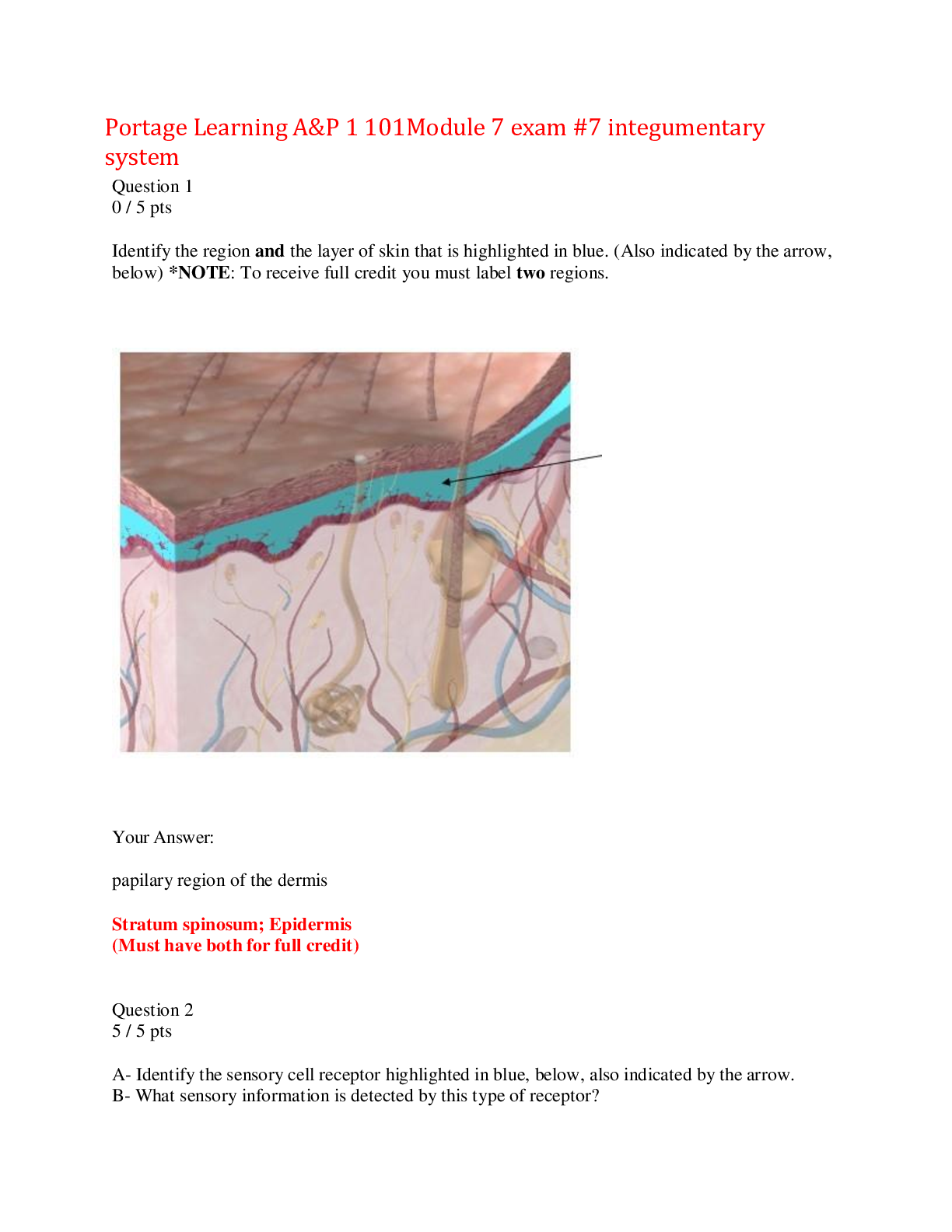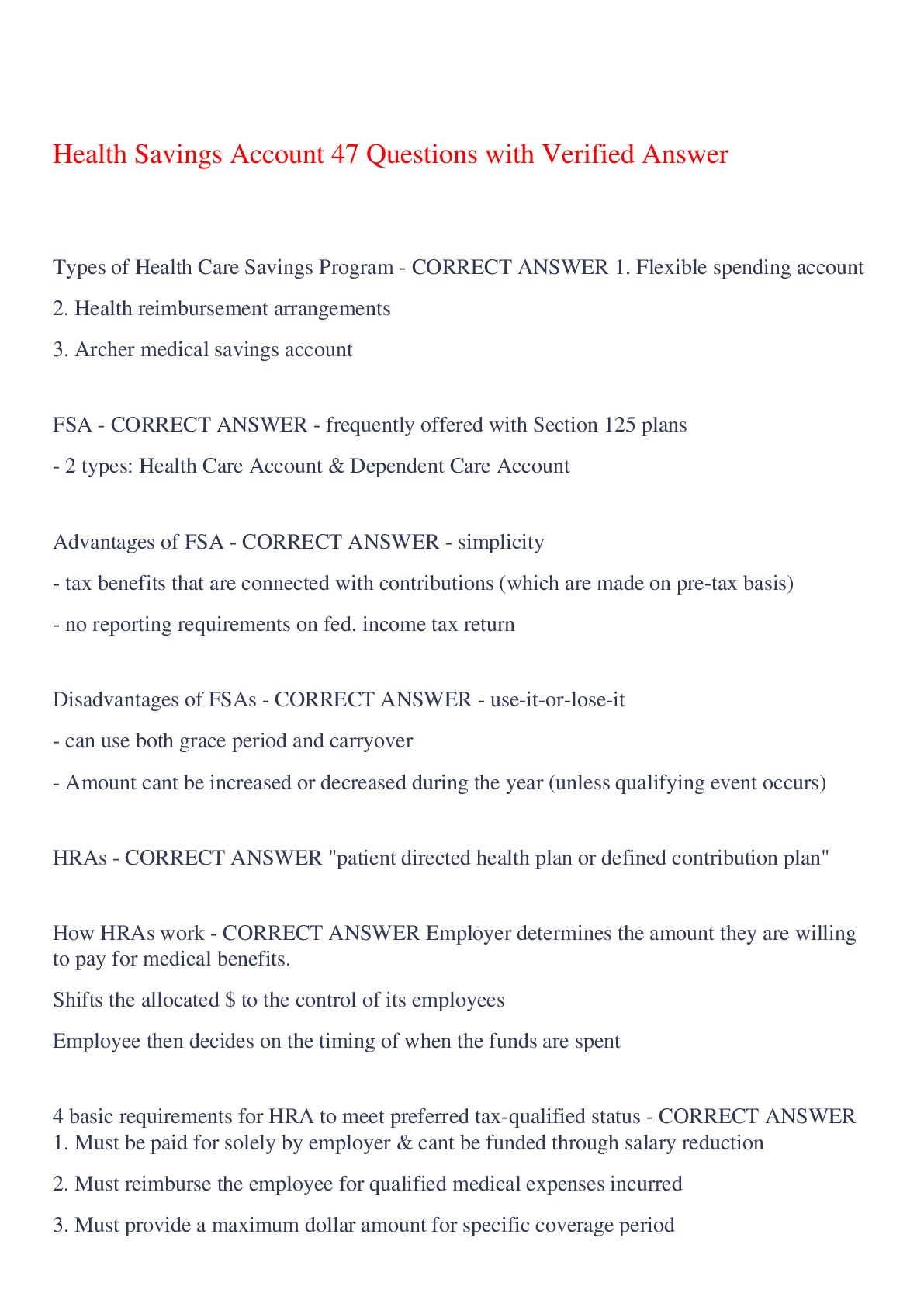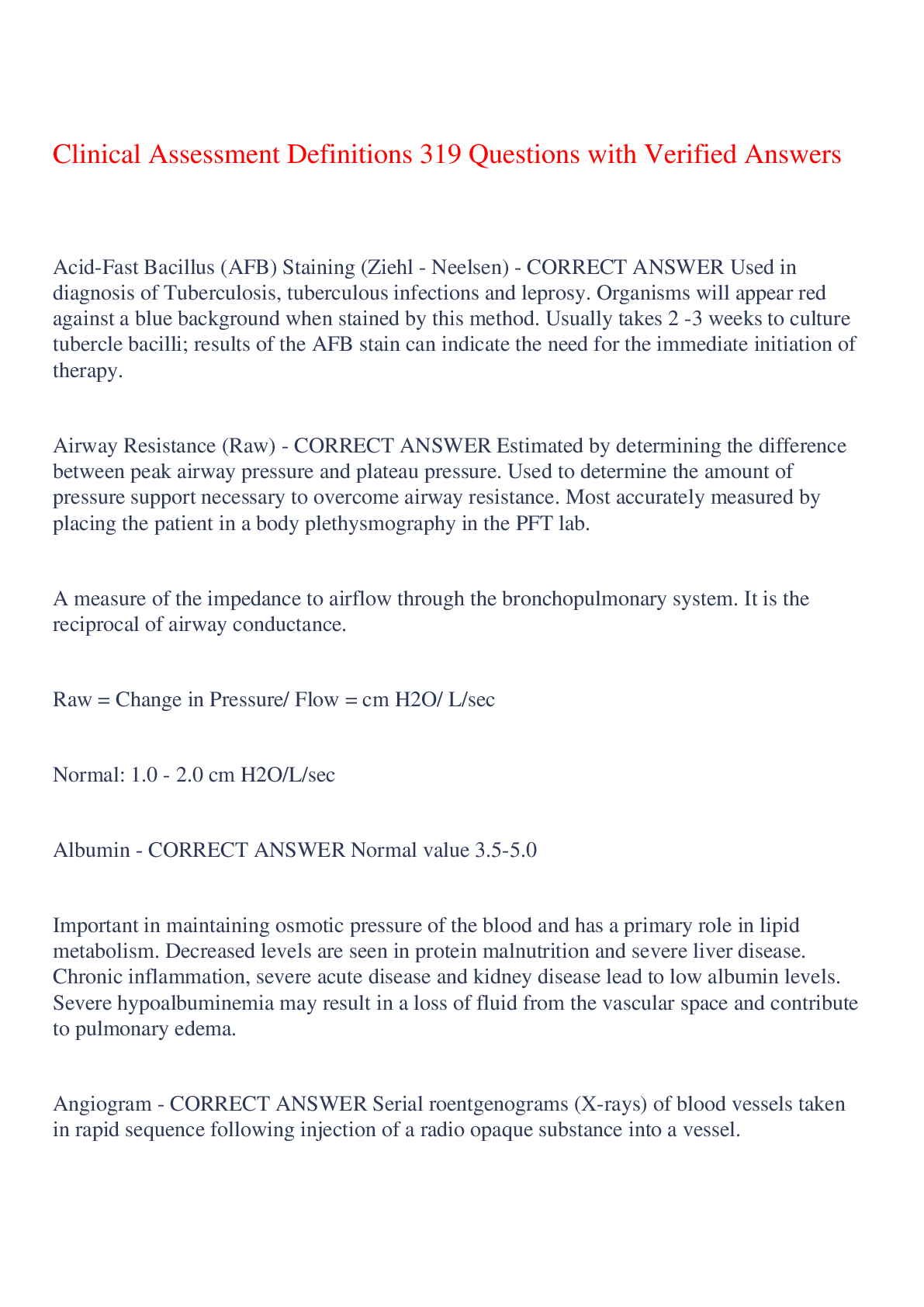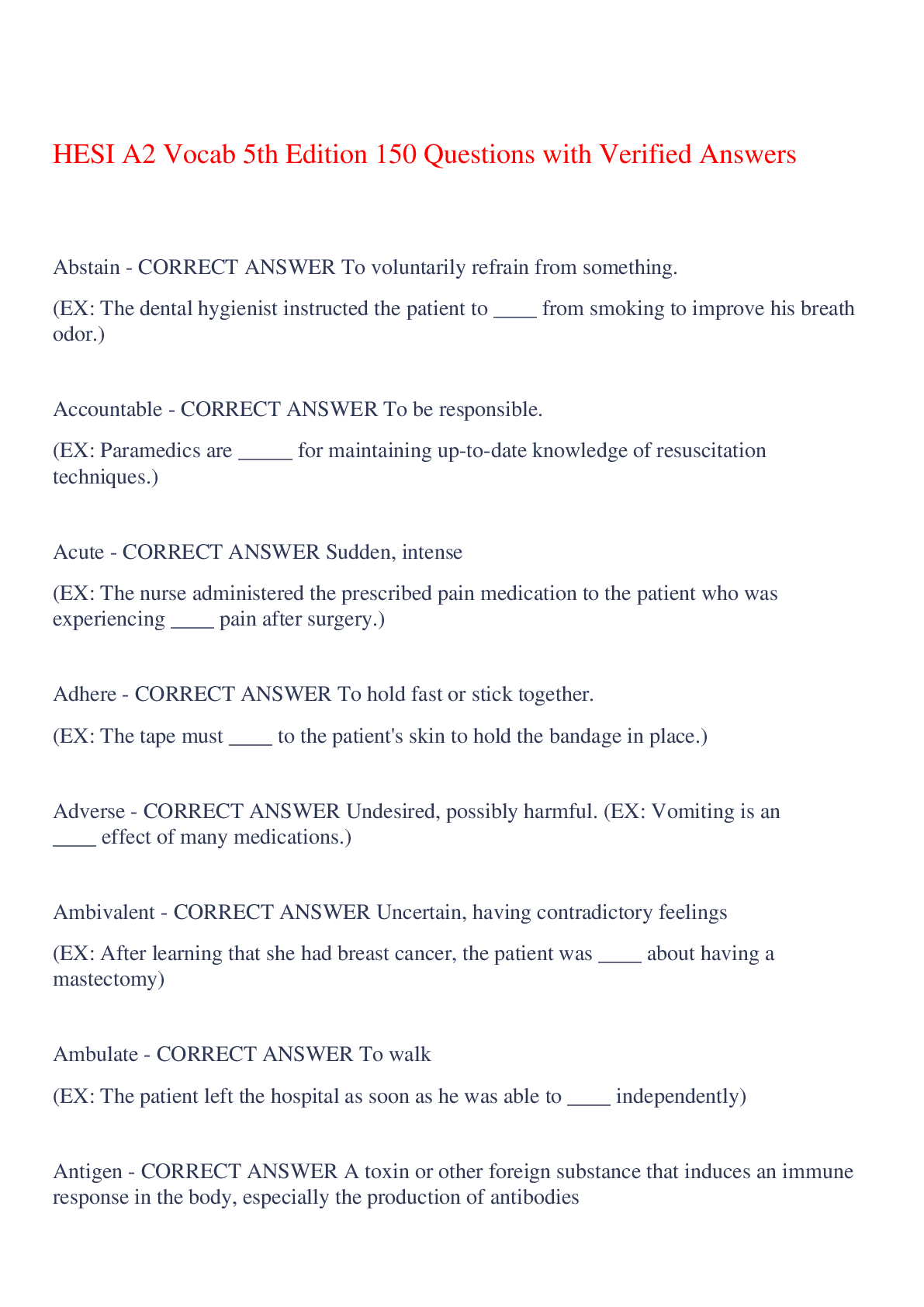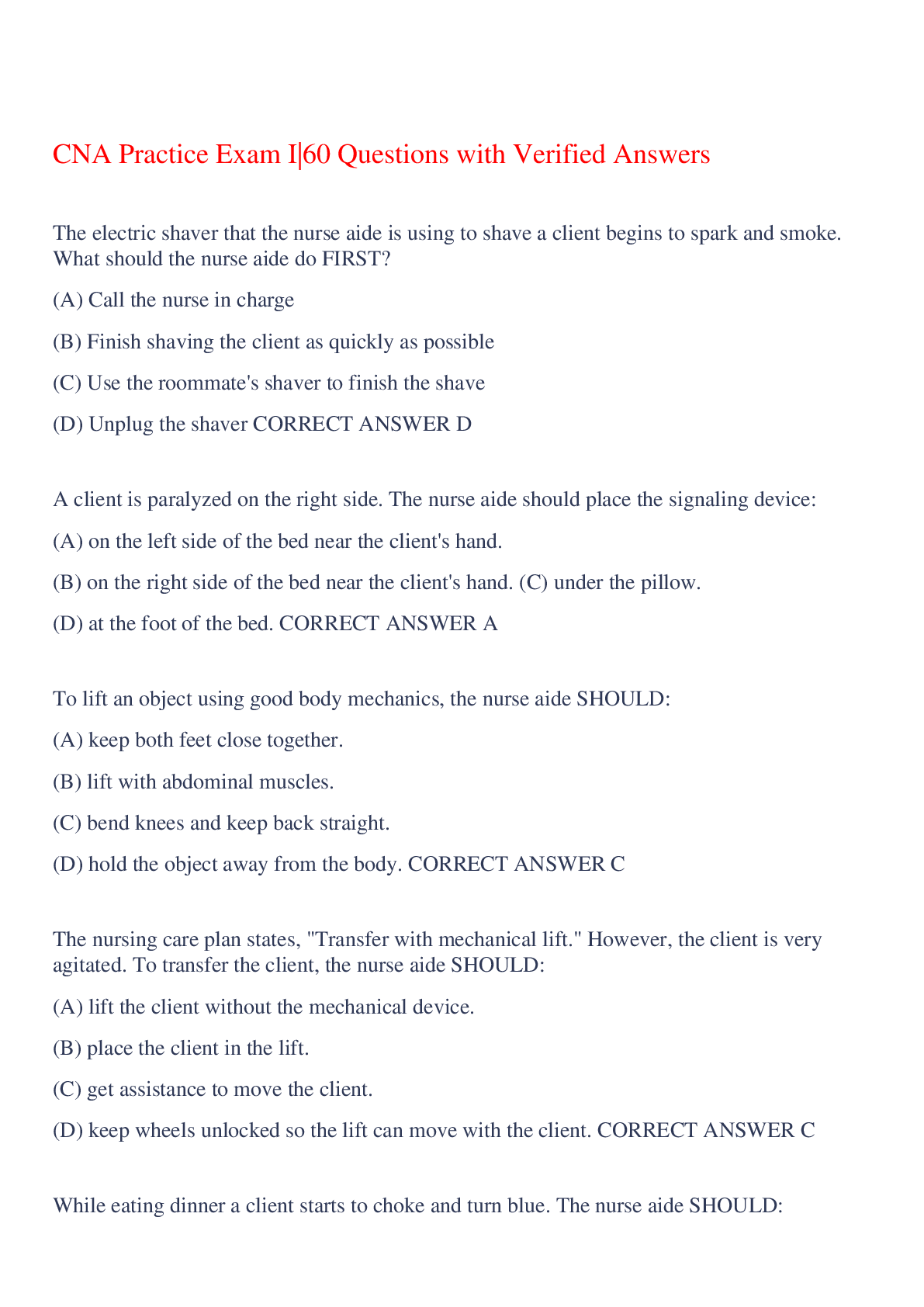CFRN Pediatrics Exam 90 Questions with Verified Answers,100% CORRECT
Document Content and Description Below
CFRN Pediatrics Exam 90 Questions with Verified Answers Who is the best historian for a pediatric patient? - CORRECT ANSWER PARENTS How is weight estimated in the pediatric patient? - CORRECT AN... SWER 1. Less than 1 year old: (age in months + 9) / 2 2. Older than 1 year: (age in years X 2) +8 BLOOD PRESSURE 1. Neonates - minimal MAP 2. Infant to 1 year old (normal) 3. 1 - 10 years old (minimum) 4. Over 10 years old (minimal) 5. Over 10 years old (normal) 5. Diastolic blood pressure? - CORRECT ANSWER 1. Gestational age in weeks = minimum MAP 2. Normal SBP is > 70 3. 70 + (age X 2) 4. 90 5. 90 + (age X 2) 6. 2/3 the systolic pressure ETT Size Formula - CORRECT ANSWER (16 + age) / 4 Pediatric ETT Depth Formula (3) - CORRECT ANSWER 1. 3 X ETT size 2. 10 + age in years 3. (age/2) + 12 Neonatal ETT Depth Formula - CORRECT ANSWER 6 + weight in kg NG/OG, Foley, Suction Catheter Formula - CORRECT ANSWER 2 X ETT size Chest Tube Size - CORRECT ANSWER 4 X ETT size 10, 11, 12 Rule - CORRECT ANSWER 1. Uncuffed ETTs for children under 10 2. Needle cric for children under 11 3. No nasal intubation for children under 12 ANATOMICAL DIFFERENCES 1. Rib cage 2. Lung tissue 3. Mediastinum 4. Fontanels 5. Liver/spleen 6. Bones - CORRECT ANSWER 1. More elastic/flexible (significant chest trauma without deformity is possible). 2. More fragile (more susceptible to pneumothorax) 3. More mobile (injuries more common). 4. Anterior fontanels close at 12-18mo, posterior fontanels close at 2mo. 5. Larger and more vascular (more susceptible to seat belt injuries). 6. It takes quite a bit of force to fracture pediatric bones. What is the cause of death in pediatric patients with cerebral hemorrhaging? How is cerebral hemorrhaging quantified in children? - CORRECT ANSWER 1. Hemorrhage (not herniation). 2. Serial measurements of head circumference. PHYSIOLOGIC DIFFERENCES 1. Cardiac output 2. Heart rate 3. Blood pressure / hypotension 4. Blood volume 5. Fluid bolus requirement 6. Sugar requirement 7. Surface area to volume ratio - CORRECT ANSWER 1. Children have a higher CO/kg ratio than adults. 2. Children have higher heart rates and smaller stroke volumes (the only way to increase CO is HR). 3. Hypotension is not evident until 25% of blood volume is lost. 4. Blood volume is 75-80ml/kg for children and 60ml/kg for neonates. 5. 20cc/kg for children, 10cc/kg for infants. 6. D25 2-4cc/kg for children (1-12), D10 2cc/kg for neonates/infants (0-12mo). 7. Larger surface area to volume ratio - they become hypothermic very easily. RENAL IMMATURITY CAUSES WHAT (2)? - CORRECT ANSWER 1. Difficulty concentrating urine and electrolytes. 2.Larger dose requirements of renally-cleared drugs. LIVER IMMATURITY CAUSES WHAT (1)? - CORRECT ANSWER Difficulty metabolizing hepatically cleared drugs (smaller dose requirements). MAINTENANCE FLUIDS 1. Neonates 2. Infants/toddlers 3. Children - CORRECT ANSWER 1. D10 at 80-100ml/kg/day 2. D5 1/4 NS + K using 4/2/1 rule 3. D5 1/2 NS + K using 4/2/1 rule *Usual dose of K is 10mEq/L 1. What is a fluid bolus? 2.What is a fluid challenge? - CORRECT ANSWER 1. A fluid bolus is given as quickly as possible. 2. A fluid challenge is given over 1 hour. RESPIRATORY / AIRWAY DIFFERENCES 1. Trachea 2. Tongue 3. Epiglottis 4. Larynx 5. Vocal cords 6. Narrowest portion of airway 7. Oxygen consumption - CORRECT ANSWER 1. The trachea is narrower and has elastic rings (do not hyperextend the neck - it will kink off the airway). 2. The tongue is larger in comparison to mouth. 3. The epiglottis is short, narrow, and angled away from the long axis of the trachea. 4. The larynx is higher and more anterior. 5. The vocal cords have a lower attachment. 6. The cricoid cartilage is the narrowest portion of the airway. 7. Oxygen consumption in pediatrics is 6-8ml/kg (versus 3-4ml/kg in adults). CROUP 1. Definition? 2. Sign and symptoms? 3. Treatment? - CORRECT ANSWER 1. Croup is a viral infection that occurs in young children (usually 4 or younger). 2. Barking cough, subglottic swelling, and a steeple sign on a neck x-ray. 3. Racemic epinephrine, humidified oxygen, and occasionally intubation or heliox. EPIGLOTTITIS 1. Definition? 2. Signs and symptoms? 3. Treatment? - CORRECT ANSWER 1. Epiglottitis is an infection of the epiglottis that can occur at any age. 2. Symptoms come on suddenly and progress rapidly. The patient will sit forward and have copious amounts of drooling. A lateral neck x-ray will show a thumb sign. 3. Keep the patient calm and comfortable. Avoid any procedure that could agitate them. Consider expert intubation prior to transport. If the patient will not be intubated, put them in a position of comfort and leave them alone. BRONCHIOLITIS 1. Cause? 2. Signs and symptoms? 3. Treatment? 4. What precautions should be taken? - CORRECT ANSWER 1. Bronchiolitis is usually viral (most often RSV). 2. Excessive mucous production, spasming of the lower airways, and alveolar collapse (due to surfactant drying out). Infants with bronchiolitis stop eating (they can't eat and breathe at the same time). 3. Supportive - administer fluids, oxygen, and parental nutrition. 4. DROPLET PRECAUTIONS PHARMACOLOGY - DOSES 1. Adenosine 2. Atropine 3. Dobutamine 4. Dopamine 5. Epinephrine 6. Lidocaine 7. Naloxone 8. Sodium Bicarbonate - CORRECT ANSWER 1. 0.1 to 0.2 mg/kg 2. 0.02 mg/kg (min 0.1, max 0.5) 3. 2-20mcg/kg/min 4. 2-20mcg/kg/min 5. 0.01mg/kg 1:10,000 IV, 0.1mg/kg 1:1000 ETT, 0.1-1.0mcg/kg/min 6. 1mg/kg 7. < 20kg 0.1mg/kg, > 20kg 2.0mg 8. 1mEq/kg or 0.3XkgXBE What are the three parts of pediatric assessment? - CORRECT ANSWER 1. LOC 2. Perfusion status - color, cap refill, and distal pulses 3. WOB What is a child's first compensatory mechanism? - CORRECT ANSWER Children shunt blood to the core - their distal extremities will be mottled and their cap refill will begin to lengthen. What is the maximum time you should spend getting an IV on a child that needs resuscitation? - CORRECT ANSWER 90 seconds What is the dose for synchronized cardioversion? - CORRECT ANSWER 0.5J/kg then 1J/kg What is the dose for defibrillation? - CORRECT ANSWER 2J/kg, then 4J/kg COMMON INJURIES 1. Solid organs 2. Hollow organs 3. Fractures 4. Waddell's Triad 5. Single largest cause of traumatic death? - CORRECT ANSWER 1. Brain, lungs, liver, spleen, pancreas, and kidneys. 2. Proximal jejunum, duodenum, and bladder. 3. Multiple long bone fractures suggest significant force. 4. Three impacts of car versus pedestrian: the vehicle impacts the legs, the head and trunk strike the hood of the car, and the body strikes the ground. 5. Motor vehicle related accidents. When should you suspect abuse? - CORRECT ANSWER 1. The history doesn't match the injury. 2. Multiple injuries in various stages of healing. 3. Genitourinary infections or injuries. What is the most commonly abused organ in children? - CORRECT ANSWER SKIN (dipping, scalding, cigarette burns, etc.) What is the most common cause of non-accidental trauma death? - CORRECT ANSWER Head injuries (shaken baby syndrome) COMMUNITED FRACTURE - CORRECT ANSWER The bone is broken into several fragments. COMPOUND FRACTURE - CORRECT ANSWER The bone is broken and piercing the skin. COMPRESSED FRACTURE - CORRECT ANSWER One bone is forced against another. DISPLACED FRACTURE - CORRECT ANSWER The ends of the fractured bone are not aligned. GREENSTICK FRACTURE - CORRECT ANSWER The periosteum of the bone is disrupted on only one side. PATHOLOGIC FRACTURE - CORRECT ANSWER A fracture occurs because of a bone defect. SIMPLE FRACTURE - CORRECT ANSWER A fracture is a straight and in good alignment. SPIRAL FRACTURE - CORRECT ANSWER A fracture resulting from a twisting motion (have a high index of suspicion for abuse). SEIZURES 1. Two etiologies 2. Four types of seizures - CORRECT ANSWER 1. Primary (brain abnormality) and secondary (a symptom of disease not related to the brain). 2. Subtle, Clonic, Tonic, and Myoclonic. SUBTLE SEIZURE - PRESENTATION - CORRECT ANSWER Repetitive mouth or tongue movement, bicycling of the hands and/or feet, eye movement or deviation, and repetitive blinking. The younger the child, the more likely they are to experience subtle seizures. CLONIC SEIZURE - PRESENTATION - CORRECT ANSWER Repetitive jerking movements of the limbs. TONIC SEIZURE - PRESENTATION - CORRECT ANSWER Posturing or tonic extension (sustained rigidity). These seizures are usually seen in older children. MYOCLONIC SEIZURE - PRESENTATION - CORRECT ANSWER Multiple jerking motions, usually involving only the upper extremities. THERMOREGULATION 1. How is hypothermia different in pediatric patients? 2. How often should a pediatric patient's temperature be taken in transport? - CORRECT ANSWER 1. The hypermetabolic state is much shorter due to limited glycogen stores. The hypometabolic state is accompanied by neurologic changes and signs of decreasing perfusion. 2. Continually via rectal or skin probe and q 30-60 minutes orally or temporally to verify the continuous temperature. For each 1 degree Celsius above 37 degrees, heart rate increases by _____ and respiratory rate increases by _____ breaths per minute. - CORRECT ANSWER 20 beats / min, 10 breaths / min What is the treatment for fever? - CORRECT ANSWER External cooling measures, Motrin, and APAP. Prevent shivering during external cooling measures and do not use ASA. Also, do not use Motrin in children under 6mo. MECHANICAL VENTILATION CHILDREN 1. FiO2 2. Vt 3. I:E 4. PIP 5. RR 6. PEEP - CORRECT ANSWER 1. 1.0 2. 6-10ml/kg 3. 1:1 4. <40 5. 16-20 6. 3-5 MECHANICAL VENTILATION INFANTS 1. FiO2 2. I time 3. PIP 4. RR 5. PEEP - CORRECT ANSWER 1. 1.0 2. 0.5-1.0 3. 15-20 4. 20-30 5. 3-5 INFANT ETT SIZE 1. < 1KG 2. 1-2KG 3. 2-3KG 4. >3KG - CORRECT ANSWER 1. 2.5 2. 3.0 3. 3.5 4. 4.0 NEONATAL TRANSPORT 1. Parameters for transporting in an isolette. 2. Isolette temperature. - CORRECT ANSWER 1. <5kg or < 30 days 2. <2500g: clothed 28, unclothed 33 1501-2500g: clothed 31, unclothed 35.5 <1500g: clothed 33, unclothed 36.5 How do we keep neonatal patients warm? - CORRECT ANSWER Pre-warm the isolette, keep the ambulance/aircraft warm, keep the patient dry, keep the patient's head covered, give warmed gasses via ETT, use commercial heat packs, wrap the infant in plastic/aluminum foil, place warmed saline gauze over open defects, and administer warmed IV fluids. OVERSTIMULATION COMPLICATIONS - CORRECT ANSWER Overstimulation causes hypertension which can cause a brain bleed. Create a dark/quiet environment, use isolette covers to limit light/noise, and stay out of the isolette as much as possible. When do we consider not resuscitating? - CORRECT ANSWER 1. <500g 2. Confirmed Trisomy 13 or 18 3. Congenital hydrocephalus 4. Gestational age < 24w 5. Severe fetal growth restriction NRP BASICS - CORRECT ANSWER 1. Suction, dry, stimulate 2. Assess for bradycardia (<100bpm). Use PPV for bradycardia or ineffective respirations. Re-evaluate after 30 seconds. 3. If HR is below 60, start chest compressions. 4. If HR remains below 60, intubate and give epinephrine. STABLE - 5 priorities - CORRECT ANSWER 1. Sugar - a normal BGL in a neonate is > 40. Give D10 to maintain a BGL of 40 or greater. 2. Temperature - keep the patient warm. 3. Airway - assess the patient for respiratory distress. 4. Blood pressure - MAP should be equal to the neonate's gestational age in weeks. 5. Lab Work - calculate the ANC (absolute neutrophil count) to evaluate for sepsis. Administer ampicillin or gentamycin for confirmed / suspected sepsis. 6. Emotional support - emotionally support the parents. OMPHALOCELE - definition and treatment - CORRECT ANSWER A protrusion of the viscera and/or abdominal contents through the umbilical ring. Cover abdominal contents with a warm/moist dressing and then an occlusive dressing. Protect from hypothermia. GASTROCHISIS - definition and treatment - CORRECT ANSWER A protrusion of the viscera through the abdominal wall. Cover abdominal contents with a warm/moist dressing and then an occlusive dressing. Protect from hypothermia. VOLVULUS / INTUSSUSCEPTION - definition and treatment - CORRECT ANSWER Twisting or telescoping of the intestines. This is a surgical emergency. Monitor fluids and electrolytes. Keep the patient NPO and prevent hypothermia. NEC (necrotizing enterocolitis) - definition and treatment - CORRECT ANSWER Abdominal distension and GI bleeding as a result of hypoxia (the bowel becomes so hypoxic that it becomes necrotic). Keep these patients NPO, support their hemodynamics and electrolytes, and place an NG/OG. ABDOMINAL HYPERTENSION - cause and treatment - CORRECT ANSWER This is usually caused by fluid resuscitation. Limit fluids and watch for end organ perfusion problems. CHOANAL ATRESIA - definition and treatment - CORRECT ANSWER A permanent bony structure at the back of the nasopharynx. These patients will be pink when crying and blue when quiet. Place the patient in position where they are stimulated to breathe (on their belly). If this doesn't work, try an oral airway or intubation. Pertussis requires which type of isolation precautions? - CORRECT ANSWER Droplet A nurse is transporting an intubated child with a diagnosis of pertussis who develops severe paroxysmal coughing. The oxygen saturation drops to 78% and the patient has a 20 second grand mal seizure. What should be administered? - CORRECT ANSWER Sedation and analgesia. Following prolonged mask ventilation, a pediatric patient is intubated and mechanically ventilated. The flight nurse inserts an NG tube. The nurse will be able to tell the NG produced the desired effect by monitoring what? - CORRECT ANSWER PIP (it should decrease) A child with congenital hydrocephalus has a VP shunt in place. The first sign of shunt displacement and malfunction is? - CORRECT ANSWER General irritability DIAPHRAGMATIC HERNIA 1. Cause? 2. Signs and symptoms? 3. Treatment? - CORRECT ANSWER 1. A birth defect that prevents the diaphragm from completely forming. Abdominal organs grow into the chest and prevent the lung from developing on the affected side. 2. Frank respiratory distress. 3. Intubation, PPV, and OG with suction. Keep the patient NPO and anticipate persistent pulmonary hypertension. RESPIRATORY DISTRESS SYNDROME (hyaline membrane disease) 1. Cause? 2. Signs and symptoms? 3. Treatment? - CORRECT ANSWER 1. Non-cardiogenic pulmonary edema caused by breakdown of the alverolar/capillary membrane (ARDS). This is common in premature infants and is compounded by surfactant deficiency. 2. Symptom onset is 3-6 hours after birth. 3. CPAP, intubation, surfactant, and antibiotics (for severe cases). AIR LEAK SYNDROME 1. Cause? 2. Signs and symptoms? 3. Treatment? - CORRECT ANSWER 1. Pneumothorax or pneumomediastinum. Usually occurs in neonates as a result of high PIP ventilation. 2. Increased difficulty perfusing and ventilating. 3. Needle aspiration at the 2-3 IC space midclavicular line or 4-5 IC space anterior axillary line. Anticipate the need for a chest tube. PULMONARY HYPOLASIA 1. Cause? 2. Signs and symptoms? 3. Treatment? - CORRECT ANSWER 1. Poor lung development prevents the alveoli from coming into contact with the capillaries (there is poor development of the alveolar/capillary membrane). 2. Hypoxia, hypoinflated lungs on x-ray (will appear white), and mediastinal shifting toward the affected lung (opposite of a pneumothorax). 3. Oxygen, CPAP, intubation, surfactant, high frequency ventilation, and ECMO. PERSISTENT PULMONARY HYPERTENSION 1. Cause? 2. Treatment? - CORRECT ANSWER 1. Hypoxia that has not been addressed quickly. Sustained hypoxia causes pulmonary artery constriction leading to right ventricular hypertrophy. Deoxygenated blood shifts across the foramen ovale (right to left) and there is a mixing of oxygenated / unoxygenated blood. 2. Maximize oxygen delivery and minimize oxygen demand. Any of the following will cause dilation of the pulmonary arteries and ease this condition: a. Sedate/paralyze the patient b. Keep the patient alkalotic with hyperventilation and sodium bicarbonate c. Nitric oxide d. Calcium channel blockers (IV) Other therapies are ECMO and anticoagulation. NEONATAL SEPSIS 1. Cause? 2. Signs and symptoms? 3. Treatment? - CORRECT ANSWER 1. PROM, maternal UTI, and Group B strep. 2. Sepsis usually manifests itself as meningitis or respiratory distress in a neonate. It is diagnosed via the ANC (absolute neutrophil count). 3. Obtain cultures, manage ABCs, replace fluids, and administer vasopressors/inotropes and ampicillin/gentamycin. NEONATAL DISTRESS - 2 CAUSES - CORRECT ANSWER 1. Respiratory Disease 2. Cardiac Disease RESPIRATORY DISEASE 1. When do symptoms appear? 2. What are the risk factors? - CORRECT ANSWER 1. Usually present at birth. 2. Risk factors are premature birth, meconium aspiration, and C-section delivery (amniotic fluid is not squeezed out of the lungs by passage through the birth canal). CARDIAC DISEASE 1. Signs and symptoms? 2. How is cardiac disease differentiated from respiratory disease in the neonate? 3. When do symptoms appear? - CORRECT ANSWER 1. Heart murmur, hepatomegaly (from CHF), decreased perfusion, and tachypnea without grunting/retractions. 2. Place the patient on oxygen. If their PaO2 and SpO2 do not improve, the patient has cardiac disease. 3. Hours after birth. CYANOTIC HEART DEFECTS (4) - CORRECT ANSWER 1. Transposition of the Great Vessels 2. Coarctation of the Aorta 3. Tetrology of Fallot 4. Hypoplastic Left Heart Disease ACYANOTIC HEART DEFECTS (2) - CORRECT ANSWER 1. Ventricular Septal Defect 2. Patent Ductus Arteriosus NEONATAL CONGESTIVE HEART FAILURE 1. Signs and symptoms? 2. Treatment? - CORRECT ANSWER 1. Shortness of breath on exertion (primarily eating), diaphoresis, pallor, grayish color, crackles in the lungs, hypoxia, and hepatomegaly. 2. Oxygen (unless the patient is ductal dependent), morphine, Lasix, Digoxin, Dobutamine, Epinephrine, and phosphodiesterase inhibitors. VENTRICULAR SEPTAL DEFECT 1. Definition? 2. Signs and symptoms? 3. Treatment? - CORRECT ANSWER 1. There is a hole between the left and right ventricle. This causes a left to right shunt. 2. The right heart becomes overloaded - pulmonary congestion, pulmonary hypertension, CHF symptoms, and right ventricular hypertrophy occur. The patient will have a murmur. 3. Many VSDs close on their own, but some require a surgical patch. Administer oxygen, morphine, Lasix, Dobutamine and Digoxin (CHF treatment). PATENT DUCTUS ARTERIOSUS 1. Definition? 2. Signs and symptoms? 3. Treatment? - CORRECT ANSWER 1. The PDA fails to close. Blood from the left ventricle gets pushed through the PDA and back into the lungs (bypassing systemic circulation). 2. Pulmonary edema and respiratory failure. 3. For an isolated PDA, administer indomethacin and oxygen to accelerate PDA closure. Surgery may be needed for closure in some cases. If the patient also has cyanotic heart defect, the PDA must remain open. In these cases, do not give oxygen and administer PGE1 to maintain PDA patency. TRANSPOSITION OF THE GREAT VESSELS 1. Definition? 2. Signs and symptoms? 3. Treatment? - CORRECT ANSWER 1. The great vessels are reversed. The aorta is connected to the right ventricle thereby perfusing the body with unoxygenated blood. A patent ASD, PFO, VSD, or PDA is needed to maintain mixing of oxygenated and unoxygenated blood. 2. Progressive hypoxemia during the first 24 hours of life as the PDA begins to close. 3. Administer PGE1 to maintain PDA patency. Keep FiO2 low to prevent closure of the PDA. Definitive treatment is surgical - a temporary VSD is created or a Jantene procedure is performed (a Jantene procedure is the permanent fix). What is a side effect of PGE1? - CORRECT ANSWER APENA AND HYPOVENTILATION - THESE PATIENTS SHOULD BE INTUBATED FOR TRANSPORT COARCTATION OF THE AORTA 1. Definition? 2. How is it diagnosed? - CORRECT ANSWER 1. Narrowing of the aortic arch just distal to the LSC artery bifurcation. 2. Diagnosis is made by taking pulses and SpO2 readings on all four limbs. Coarctation distal to the LSC artery causes poor SpO2/pulses in the lower extremities. Coarctation between the LSC and RSC artery causes poor SpO2/pulses in the RUE, LLE, and RLE. This defect is commonly associated with a VSD. COARCTATION OF THE AORTA 1. Signs and symptoms? 2. Treatment? - CORRECT ANSWER 1. Decreased aortic flow results in high left ventricular pressure and left ventricular failure (CHF). 2. Administer oxygen, morphine, Lasix, Dobutamine and Digoxin (CHF treatment). TETROLOGY OF FALLOT 1. Definition? 2. Signs and symptoms? - CORRECT ANSWER 1. VSD + pulmonary artery outflow stenosis + right ventricular hypertrophy + rightward displacement of the aorta (dextroposition of the aorta). 2. Blood preferentially enters the aorta from the right ventricle (instead of the pulmonary artery). RVH causes a R to L shunt. Patients are very hypoxic and prone to tet spells. 1. What is a tet spell? 2. When do tet spells peak? 3. What is the treatment? - CORRECT ANSWER 1. A sudden onset of spasming of the pulmonary artery and/or a sudden decrease in SVR secondary to hypovolemia, dehydration, hot weather, or defecation. All blood is shunted to the aorta instead of the pulmonary artery / lungs. 2. Tet spells peak between 2 and 4 months of age. 3. Put the child in a knee/chest position to increase SVR and force blood into the pulmonary arteries. Also give oxygen (if not extremely PDA dependent) and morphine. What is the treatment for Tetrology of Fallot? - CORRECT ANSWER Maintain PDA patency with PGE1 and minimize oxygen administration. Definitive treatment is surgical. HYPOPLASTIC LEFT HEART DISEASE 1. Cause? 2. Signs and symptoms? 3. Treatment? - CORRECT ANSWER 1. Minimal or non-existent left ventricle (congenital abnormality). 2. Mottling, a gray appearance, and SpO2 in the 70s or 80s. 3. Manage ABCs, administer PGE1 to maintain PDA, and administer FiO2 < .21. How should the needle be inserted when performing a needle cric? - CORRECT ANSWER Direct the needle at a 45 degree angle caudally. APGAR - CORRECT ANSWER 1. Activity - absent, arms/legs flexed, active movement 2. Pulse - absent, <100, >100 3. Grimace - flaccid, some flexion of extremities, active motion 4. Appearance - blue/pale, acrocyanosis, pink 5. Respiration - absent, slow/irregular, vigorous cry Pediatric GCS - CORRECT ANSWER 1. Eyes open spontaneously, to voice, to pain, no response. 2. Smiles/interacts, consolable / inappropriate interactions, inconsistently consolable / moaning, not consolable / agitated, no response. 3. Spontaneous/purposeful movement, withdraws to touch, withdraws to pain, pain stimulates decorticate posturing, pain stimulates decerebate posturing, no response. [Show More]
Last updated: 6 months ago
Preview 1 out of 18 pages
Instant download
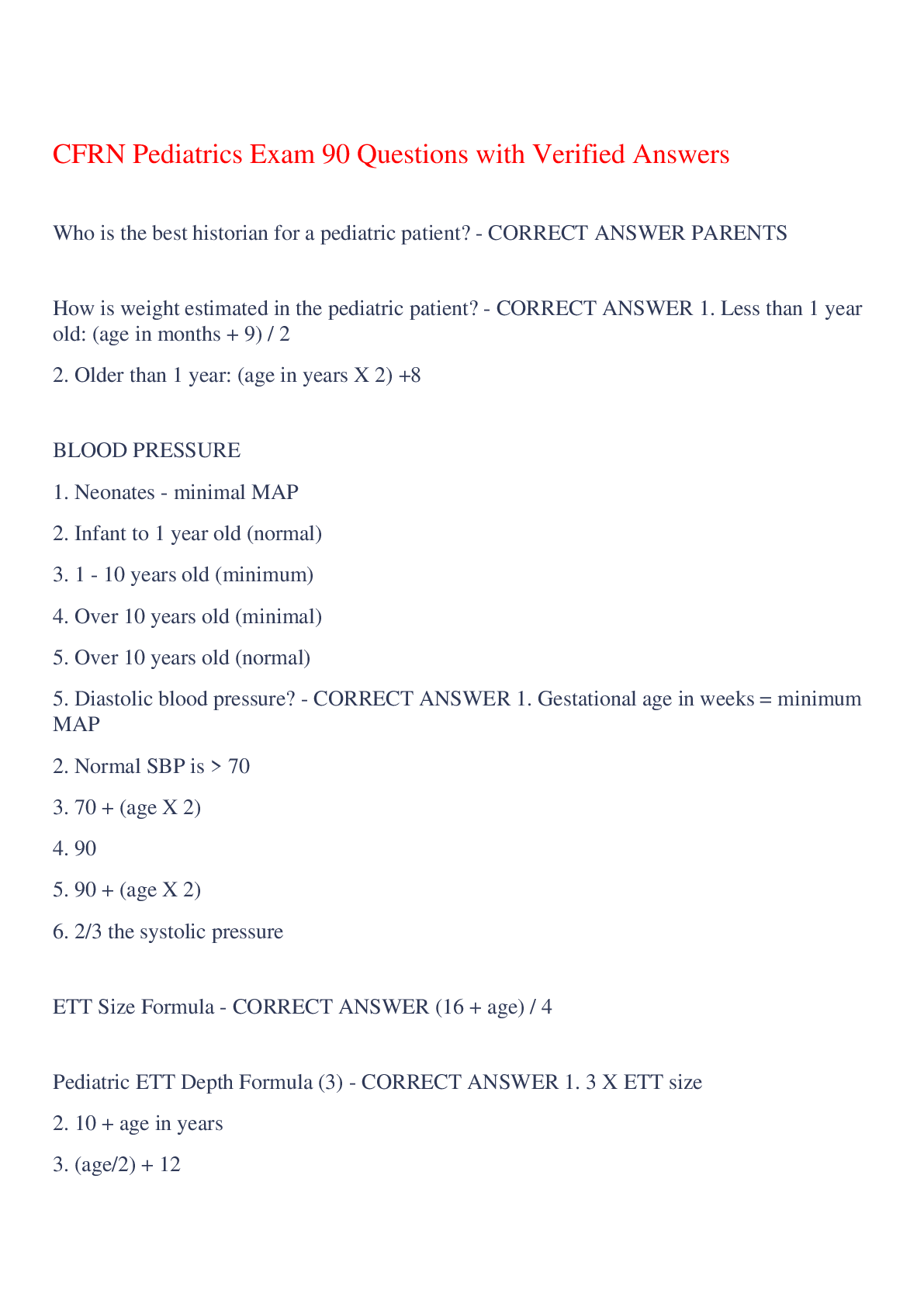
Instant download
Reviews( 0 )
Document information
Connected school, study & course
About the document
Uploaded On
Nov 07, 2023
Number of pages
18
Written in
Additional information
This document has been written for:
Uploaded
Nov 07, 2023
Downloads
0
Views
35






